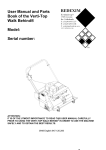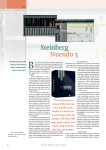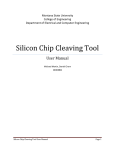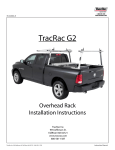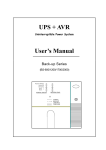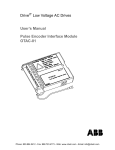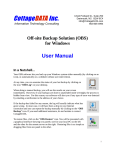Download Human Power Take Off Owner`s Manual
Transcript
Pretty good overall, & good balance of images & text instructions. Good initial checklist & parts list. Some additional warnings could have been included. Human Power Take Off Owner’s Manual A.How to Operate the System WARNING: The power take off (PTO) unit is capable of achieving speeds up to 2000 RPM. It is essential that whenever the system is in use, the user and onlookers keep hands, hair, clothing, and any accessories clear from moving parts. Failure to do so will result in serious injury. 1. Basic Use Checklist a. To properly set up the system for usage, the following items will be needed: i. PTO/ Vertical Adaptor (if needed) ii. Input source (Bicycle and Healthy Human Preferred) iii. Bicycle Stand iv. Master Linked Bicycle Chain (50”) v. Mounting Board vi. C-Clamps for Mounting vii. Tools: 1. Wrench 2. Allen Keys (ANSI) 2. Basic Set-Up/Assembly a. Mounting i. First clamp the mounting board down to the table that the PTO will be operating on with the supplied C-clamps (3). 1. Tighten clamps down as tight as possible using your hands only. 2. For best performance set the PTO long ways with the table so that the bike will be facing out from the end. ii. Screw the PTO into the mounting board with the 1/4” thumb screws in the desired location. Again, tighten down the thumb screws as snug as possible through hand tightening. The tensioning handle side (input side) of the PTO needs to be on the edge of the table in order to function. 1. The different mounting locations are so that other appliances can be hooked up to it. The middle location is the main position for the vertical adaptor and coffee grinder. Figure 1: Clamp Mounting Board to Table. Figure 2: Mount PTO with Thumb Screws b. Input Hook Up i. Bicycle 1. Using an Allen key attach the input sprocket so that the set screw is on the flat of the input shaft. The sprocket should be 2.5” to 3.5” from the side of the PTO. 2. Set the bike so that it is at the end of the table and facing away from it. 3. For maximum speed the bike should be in top gear and the extra chain should be wrapped around the larger gear in the back. 4. The chain is also wrapped around the input sprocket and the master link is connected by bending and snapping into place. 5. Ensure that the chain is tight and straight by pulling the bike straight and looking down the chain toward the PTO. ii. Hand crank 1. Using an Allen key torque down the set screw onto the flat of the input shaft. iii. Other Inputs (Requires Ingenuity) 1. The PTO has the option for a belt/chain or hand crank input. If any other device is to be used it must be adapted to the correct size V-belt or a standard bike chain. Other pulleys with set screws and a ½” bore can also be used to adapt other belts. c. Speed vs. Torque i. The speed/torque of the output depends on two things: 1. The input from the user. a. This system is designed for a 60 RPM input between 1/4 1/3 Hp. b. The user should not try to over exert him/herself. c. The maximum power input should be 1/3 Hp. 2. The pulley ratios. Table 1: Speed/Torque Pulley Ratios Speed/Torque Input Pulley Output Pulley High/Low Largest Smallest Medium High/Medium Low 2nd Largest 2nd Smallest Medium Low/Medium High 3rd Largest 3rd Smallest Low/High Smallest Largest Speed/Torque Arrangement: Medium Low/Medium High ii. Changing PTO speeds: 1. Un-tension belt by pulling handle out and turning clockwise.\ 2. Open Lid of PTO. 3. Switch belt to desired pulleys based on speed/torque needs and the above speed/torque table. d. Appliance Attachment i. Horizontal 1. Current Appliances a. Coffee Grinder i. Attach 2” pulley to the output shaft of the PTO and the input shaft of the coffee grinder. ii. Align the pulley from the coffee grinder and the pulley from the PTO so that they are in line for the belt. iii. Wrap the belt around the pulley on the PTO around the pulley on the coffee grinder. iv. Once the belt is in line, tension it so that there is a 1.5” gap between the PTO and the base of the coffee grinder. This will allow for the right amount of tension so that the coffee grinder can be run properly. b. Bench Grinder i. Attach 2” pulley to the output shaft of the PTO and the input shaft of the bench grinder. ii. Slide the belt onto the pulleys. iii. Mount the bench grinder to the mounting board in the pre located holes for the bench grinder. iv. This will allow for proper distance between pulley s for the belt to be used. 2. New Appliances a. Look for data regarding input motor’s power, speed, and torque. b. Assess shaft location and look for attachment point. c. Add pulley or hose coupler to shaft. ii. Vertical 1. Current Appliances a. Blender i. Fit the coupler over the output shaft of the PTO and the horizontal shaft of the vertical adapter. ii. Screw in the vertical adapter to the mounting board’s pre located holes for the vertical adapter. iii. Tighten the coupler to both shafts to a snug fit that can be achieved by hand tightening. iv. Place the blender attachment to the vertical part of the shaft. 2. New Appliances a. See section for new horizontal appliances. e. Internal Assembly i. NOTE: These steps will NOT be done with daily operation of the PTO. These instructions should be used when the following needs to be performed: 1. Replacing the belt. 2. Replacing pulleys. 3. Replacing the bearings. 4. Replacing the shafts ii. Mount the two bearings onto the PTO with the bearings facing the inside of the unit. One bearing will be used for each shaft. iii. Insert the 16” shaft into the input shaft side of the unit. This is the side opposite that of where the pipe belt tensioning roller is. Slide on half of the shaft. Do not insert it all the way into the bushing side. 1. Slip on a snap ring far enough down the shaft to allow for the pulleys to be inserted. 2. Slide on the largest conical pulley (6”,5”4”) first with the keying attachment. The 6” side of the pulley needs to be nearest the bearing side of the unit. 3. Slide on the 2” pulley and lock it down with the set screw. This pulley should be flush with the large conical pulley. 4. Slide on another snap ring. 5. DO NOT lock down the shaft at the bearing or with the snap rings. Leave about 2” or 3” between the end of the shaft and the bushing side of the PTO. iv. Insert the 10” shaft into the output side of the unit. This is the side nearest the pipe belt tensioning roller. Slide on half of the shaft. Do not insert it all the way into the bushing side. 1. Slip on a snap ring far enough down the shaft to allow for the pulleys to be inserted. 2. Slide on the 4”, 3”, 2” pulley onto the shaft. Make sure the larger pulley is on the bearing side of the unit. 3. Slide on the 1.5” pulley. 4. Slide on another snap ring using the snap ring tool. 5. DO NOT lock down the shaft at the bearing or with the snap rings. Leave about 2” or 3” between the end of the shaft and the bushing side of the PTO. v. Insert the V-belt between the 2”-3” gap left between the end of the shafts and the bushing side of the unit. vi. Once the V-belt is on the shafts, slide all the snap rings into the grooves to lock the shaft in place. vii. Now align the pulleys and lock them down tightly. Top view of the internal assembly operation. External assembly with the chain attaching from the rear bicycle hub to the input sprocket of the PTO. 3. How to Operate System WARNING: It is important to keep hands, clothing, hair, and accessories away from all rotating parts. DO NOT operate the PTO without the lid shut and the casing securely attached. a. What Pulley Ratio? Pulley Ratio 06:01.5 5:02 4:03 Output RPM 1330 830 455 Torque (lb*in) 17 27 50 NOTE: These speeds and torques were achieved through an input of around 1/3 Horse Power at a moderate exertion level. i. Assemble the V-belt to the desired output speed and torque. ii. Two users are required to properly operate the unit. 1. User to pedal the bicycle to power the appliance. 2. User to work the appliance. iii. The belt tensioning bracket should now be implemented to put a large enough force on the belt tensioning handle to ensure no slip occurs. iv. The pedaling user should carefully mount the bicycle and listen for instructions of the user operating the appliance. Once the user operating the appliance has cleared everything/everyone away from the rotating parts and loaded the appliance, it is ready for operation. b. Recommended Pulley Ratios Each appliance has a pulley ratio that is ideally suited for it. Typically, this is the ratio that allows the output shaft to spin at the maximum speed while also getting enough torque to run the appliance. The pulley ratios are diagramed below in Figure 3.1. Figure 3.1 – Available Pulley Ratios In this figure, Ai connects to Ao, Bi to Bo, etc. These provide pulley ratios that range from low (high torque and low speed) at A to overdrive (high speed and low torque) at D. These ratios are each suited for different appliances, as can be seen in table 3.1. Table 3.1 – Pulley Positions c. Maintenance While the PTO is designed to be rugged and long lasting, some routine maintenance will be required. i. Belts Belts naturally stretch and wear out over time. While the adjustable tensioner system helps to extend the usable life of the belts, they will eventually need to be replaced. In this event, the following steps should be taken 1. Loosen set screws on pulleys and bearings 2. Remove snap rings from shafts 3. Slide shafts until belt can slip off 4. Put on new belt 5. Reassemble shafts ii. Tensioner The tensioner is prone to rust, and will require periodic oiling to counteract this effect. How often oiling is required is dependent on the level of use and exposure to the elements. Simply visually inspect the tensioner for rust before each use. If rust is present, apply a light coating of machine oil. d. Troubleshooting i. Appliance is not running fast enough to be effective. 1. Pedal faster. 2. Switch to a higher pulley ratio if possible. 3. Check chain position on the rear bike hub. a. Chain going to PTO should be on the largest sprocket. b. Chain going to pedals should be on the smallest sprocket, a.k.a. the bike should be in top gear. 4. Appliance may require more power than can be produced using this device. a. Consider designs for multiple input system. ii. Appliance is barely running or not at all. 1. Check that all belts are well tensioned (can only be twisted up to 90° using fingers). 2. Check that nothing is wrong with the appliance or trapped in the appliance (example: coffee beans lodged in grinder prior to starting). 3. Check that the chain is connected properly. 4. Check that the pulleys are all tightened onto the shaft flats (both inner pulleys and outer pulleys/input sprocket). e. Parts List i. These parts can be seen in the manufacturing drawings as well. In the manufacturing drawings, you can find where the purchased items were bought through as well as the item number. Part PTO Frame Bushing Bearing 3,4,5 Pulley 4,5,6 Pulley 1.5" Pulley 3" Pulley 2" Pulley 2.5" Pulley Input Shaft Output Shaft Tension Slide Tension Handle Roller Bar Tension Bracket Tension Handle Pin PTO Long Side Panel PTO End Panel Snap Ring Qty 1 6 2 1 1 1 1 4 1 1 1 1 1 1 2 1 2 2 8 Part Shaft Key PTO Mount PTO Lid Lid Hinge Lid Knob Handle V.A. Frame V.A. input shaft V.A. output shaft V.A. Side Panel V.A. Lid Hose Coupler Hose Clamp 1/4" Thumb Screw 1/4"-20 x 1" bolt 1/4"-20 Nut 1/4" washer 8-32 bolt 8-32 nut Qty 1 1 1 4 2 2 1 1 1 2 1 1 2 10 4 4 8 8 8














